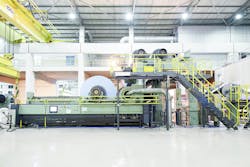ABB signs agreement with Raumaster Paper
ABB has signed a Memorandum of Understanding agreement with machine builder Raumaster Paper to jointly explore integrated winder solutions in the U.S. The two come together to help paper mills with operational efficiency and extending equipment lifecycles, combining ABB’s expertise in automation, system drives and digitalization with Raumaster Paper’s specialization in paper mill finishing equipment.
Many paper mills face increasing pressure to improve efficiency while working within tight investment constraints. Rather than requiring full system replacements, this partnership offers a practical path to modernization by enabling targeted upgrades to both control and mechanical systems. By aligning Raumaster Paper’s winder designs with ABB’s automation expertise, mills can benefit from reduced commissioning times, streamlined operation and enhanced safety, especially for aging assets.
Raumaster has been designing and manufacturing diverse machinery including paper mill finishing house equipment for more than 40 years. In this time, it has delivered more than 110 high-capacity winder and rewinder machines globally. With a strong presence in Europe and Asia and a growing footprint in North America, the company has established itself as a trusted supplier, providing reliable and adaptable solutions that support performance improvements in the pulp and paper industry.
With more than 400 successful global installations, ABB’s drive control solutions for winders are well-established in the industry. This collaboration will enable access to an optimized winder control package that seamlessly integrates with ABB’s broader automation ecosystem, including ABB Ability System 800xA, motors and drives. This end-to-end approach ensures smoother operation, easier maintenance and better visibility in machine performance, helping operators manage their finishing processes more efficiently.
“Our customers rely on high-performance, reliable winder solutions to keep their operations running smoothly,” says Pekka Leino, managing director at Raumaster Paper. “They also need future-ready systems that integrate seamlessly with the latest automation technologies. By working with ABB, we are bringing together decades of experience in winder design with industry-leading control solutions, creating a compelling, operator-friendly package for paper mills worldwide. This collaboration will help mills not only optimize efficiency and quality output but also extend the life of their equipment.”
“Paper mills today need solutions that not only improve productivity but also make life easier for their operators – especially in an industry where mills are working hard to maximize the performance of existing assets,” says Shankar Singh, global product line manager at ABB. “With our globally proven drive control solutions for winders, we’re providing mills with a smarter, more connected approach to finishing operations. Partnering with Raumaster Paper allows us to offer a seamless package that combines best-in-class automation with trusted mechanical expertise, ensuring mills can modernize efficiently and cost-effectively.”

